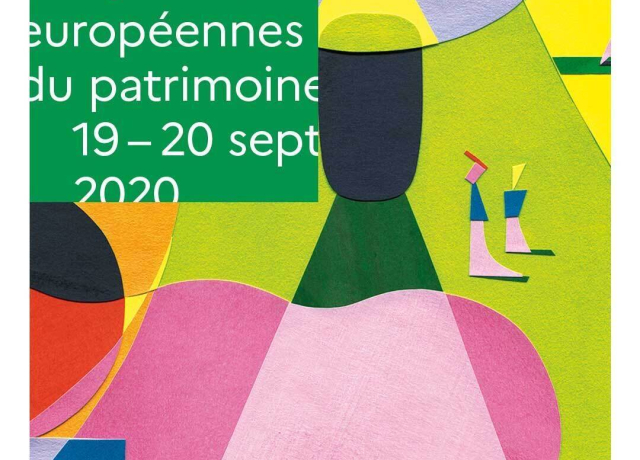European Heritage Days Article:
Looking back at this year’s European Heritage Days celebrations in France
European Heritage Days Article:
Looking back at this year’s European Heritage Days celebrations in France
The events, hosted on the third weekend of September, attracted nearly 30 million visitors across all heritage sites in France. With the aim of raising citizens' awareness of the cultural diversity of Europe and to preserve its heritage, the European Heritage Days in France was also present on the dedicated platform of the European initiative as well as on social media.
This year’s shared theme ‘Heritage and Education: Learning for life!’ inspired the organizers to not only transmit the taste and knowledge of iconic monuments of the nation, including castles, rural heritage, historic gardens, religious buildings or industrial sites to all visitors; but also, to focus especially on young people by planning numerous activities, workshops and meetings offering the opportunity to measure the importance of education in heritage and the essential role of heritage in education. Additionally, the special project “Look up!”, initiated last year by the Ministry of Culture and the Ministry of National Education and Youth, continued in 2020. The project was integrated with the theme of the year "Heritage and Education: Learning for Life!”
France is home to more than 44,000 historical monuments! Additionally, contemporary architecture is seen as the heritage of tomorrow, in that it changes our everyday environment and allows us to experience new ways of using the built space. This year, the project “Look up!” was an opportunity for students to learn and develop an eye for their daily living environment. It provided an opportunity for teachers to introduce children and young people to the importance of heritage and architecture. Through examining the design of buildings and participating workshops with heritage professionals, “Raise your eyes!” enriched the artistic and cultural vision of students. The Council of Architecture, Urbanism and the Environment (CAUE) invited teachers and their students to participate in the initiative Children of Heritage (Enfants du Patrimoine). CAUE has particularly been involved with young audiences and, through educational activities, is today an essential actor in arts and cultural education. Focusing on young people, the European Heritage Days in France hosted architectural walks, track games, workshops, guided tours, urban routes, and much more. These cultural and friendly events, led by professionals, let students discover their local heritage in direct contact with buildings, works, landscapes and local history.
Highlights
One of the special events that took place on the weekend of 18-19 September included a journey to the kingdom of foreign languages - Chukchi, Quechua, Hausa and so many others This event was hosted by the National Institute of Oriental Languages and Civilizations (Inalco) that was created in 1795. Formerly known as the Special School of Oriental Languages, the mission of this institution is to teach modern Eastern languages. At the beginning of the 19th century, a dozen languages were taught, compared to a hundred today. The historic building of the Inalco, a mansion commissioned by the Marquis of Bacqueville in 1716, still houses the House of Research and its library. The recently restored building was open to the public on this special occasion.
The Palais-Royal got creative with lots of themes relating to its gardens: the presence of the tree from the 17th century until the Revolution, the public promenade and anecdotes about outdoor activities in the 18th century. Workshops themed around Napoleon's hat or Richelieu's cat allowed visitors to learn more of the history while having fun under open air.
Considering the difficulties presented by COVID-19, the European Heritage Days in France was very diverse in virtual visits, videos and digital initiatives designed especially for the occasion.
The "The castle of Saint-Cloud: from archives to virtual restitution" was presented by Philippe Le Pareux, in which he shared his virtual reconstruction of the castle Château de Saint-Cloud.
For the first time this year, the Palais de l'Élysée offered a virtual tour of its interiors so that as many people as possible could discover it from home on its website.
Notre-Dame De Paris proposed a Live Tour of the Cathedral Reconstruction Site in partnership with Arte. This iconic monument, which is no longer open to the public is currently under reconstruction following the fire of April 2019. The public could discover the progress of the works and the history of one of the most famous cathedrals in the world with the explanations of Arte journalist, Philomène Bon.
Paris City Hall designed a virtual reality tour specifically for the European Heritage Days. Through the Instagram filter visitors could unravel the interior of the office of the Mayor of Paris. By activating one filter, you could travel through the City Hall and a second filter offered everyone the opportunity of becoming one of the emblematic characters of the paintings exhibited in the City Hall.
For the weekend, the Court of Auditors proposed a digital offer of animations and visits for following from home through its social networks. The Cambon Palace was built at the end of the 19th century and has been home to the Court of Auditors since 1912. The main task of the Court of Auditors is to ensure that public money is used correctly and to keep the public informed. Digital animation of visits, presentations by judges, counties and various videos were published on the institution’s social media.
The European Heritage Days in France is organised by the Ministère de la Culture et de la Communication / Direction générale des patrimoines (Ministry of Culture and Communication / Directorate General for Heritage) and implemented by the Directions régionales des Affaires culturelles (Regional Directorates of Cultural Affairs).
